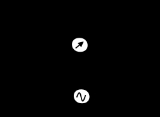
Maxwell bridge
Encyclopedia
|- align = "center"
|
|
A Maxwell bridge (in long form, a Maxwell-Wien bridge) is a type of Wheatstone bridge
used to measure an unknown inductance
(usually of low Q value) in terms of calibrated resistance
and capacitance
. It is a real product
bridge.
With reference to the picture, in a typical application and
and  are known fixed entities, and
are known fixed entities, and  and
and  are known variable entities.
are known variable entities.  and
and  are adjusted until the bridge is balanced.
are adjusted until the bridge is balanced.
 and
and  can then be calculated based on the values of the other components:
can then be calculated based on the values of the other components:


To avoid the difficulties associated with determining the precise value of a variable capacitance, sometimes a fixed-value capacitor will be installed and more than one resistor will be made variable.
The additional complexity of using a Maxwell bridge over simpler bridge types is warranted in circumstances where either the mutual inductance between the load and the known bridge entities, or stray electromagnetic interference, distorts the measurement results. The capacitive reactance in the bridge will exactly oppose the inductive reactance of the load when the bridge is balanced, allowing the load's resistance and reactance to be reliably determined.
|
|

A Maxwell bridge (in long form, a Maxwell-Wien bridge) is a type of Wheatstone bridge
Wheatstone bridge
A Wheatstone bridge is an electrical circuit used to measure an unknown electrical resistance by balancing two legs of a bridge circuit, one leg of which includes the unknown component. Its operation is similar to the original potentiometer. It was invented by Samuel Hunter Christie in 1833 and...
used to measure an unknown inductance
Inductance
In electromagnetism and electronics, inductance is the ability of an inductor to store energy in a magnetic field. Inductors generate an opposing voltage proportional to the rate of change in current in a circuit...
(usually of low Q value) in terms of calibrated resistance
Electrical resistance
The electrical resistance of an electrical element is the opposition to the passage of an electric current through that element; the inverse quantity is electrical conductance, the ease at which an electric current passes. Electrical resistance shares some conceptual parallels with the mechanical...
and capacitance
Capacitance
In electromagnetism and electronics, capacitance is the ability of a capacitor to store energy in an electric field. Capacitance is also a measure of the amount of electric potential energy stored for a given electric potential. A common form of energy storage device is a parallel-plate capacitor...
. It is a real product
Real number
In mathematics, a real number is a value that represents a quantity along a continuum, such as -5 , 4/3 , 8.6 , √2 and π...
bridge.
With reference to the picture, in a typical application
 and
and  are known fixed entities, and
are known fixed entities, and  and
and  are known variable entities.
are known variable entities.  and
and  are adjusted until the bridge is balanced.
are adjusted until the bridge is balanced. and
and  can then be calculated based on the values of the other components:
can then be calculated based on the values of the other components:

To avoid the difficulties associated with determining the precise value of a variable capacitance, sometimes a fixed-value capacitor will be installed and more than one resistor will be made variable.
The additional complexity of using a Maxwell bridge over simpler bridge types is warranted in circumstances where either the mutual inductance between the load and the known bridge entities, or stray electromagnetic interference, distorts the measurement results. The capacitive reactance in the bridge will exactly oppose the inductive reactance of the load when the bridge is balanced, allowing the load's resistance and reactance to be reliably determined.

